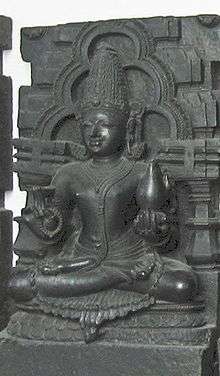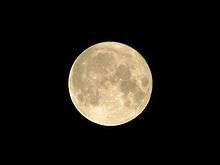Chandra
Chandra (Sanskrit: चन्द्र, IAST: Candra, lit. "shining" or "moon")[2] is a lunar deity and is also one of the nine planets (Navagraha) in Hinduism. His chief consort is Rohini. Chandra is synonymous to Soma. Other names include Indu ("bright drop"), Atrisuta ("son of Atri"), Sachin ("marked by hare"), Tārādhipa ("lord of stars") and Nishakara ("the night maker").[3]
| Chandra | |
|---|---|
God of the Moon, Lord of Night, Plants and Vegetation | |
| Member of Navagraha | |
.jpg) | |
| Other names | Soma, Chandran, திங்கள் (Thinghal - Tamil) |
| Devanagari | चंद्र |
| Affiliation | Deva, graha, Navagraha |
| Abode | Chandraloka |
| Planet | Moon |
| Mantra | Om Chandramasē Namaha |
| Weapon | Rope |
| Day | Monday, Hindi: Somvaar Sanskrit: Induvaasaram Tamil: "Thinghatkizhamai" |
| Color | Pale white[1] |
| Mount | Chariot pulled by an antelope |
| Gender | Male |
| Personal information | |
| Parents | |
| Siblings | Durvasa and Dattatreya |
| Consort | Rohini, Revathi and other 25 daughters of Daksha Tara (illegitimate) |
| Children | Varchas with Rohini, Budha with Tara (illegitimate) |
| Greek equivalent | Selene, Phoebe |
| Roman equivalent | Luna |
| Norse equivalent | Máni |
Chandra is described as a young and beautiful man, two-armed and carrying a club and a lotus.[4] In Hindu mythology, he is the father of Budha (planet Mercury).
Chandra, who is also known as Soma and Indu, is the basis of Somvaar, which is Hindi, and Induvaasaram, which is Sanskrit, for Monday in the Hindu calendar.
Mythology

In Hindu mythology, there are multiple legends surrounding Chandra.
In one, Chandra met Tara, the wife of Brihaspati (planet Jupiter) and was captivated by her beauty. Tara was also attracted to him. One day Chandra abducted her and made her his queen. From their union, Tara became pregnant, giving birth to Budha (planet Mercury). Brihaspati, being upset, declared a war but the Devas intervened and Tara was returned to Brihaspati. Budha's son was Pururavas who established the Chandravanshi Dynasty.[5]
After Tara returned to her husband Brihaspati, Chandra had an emotional breakdown because he couldn't satisfy his feelings by having infinite children with Tara and so He (Mind) was overcome with lust (emotions). He married Daksha's 27 daughters to sate his ever-growing desires for sexual union. Among all of his 27 wives, Rohini is the most favoured. The 26 other wives became upset (after knowing that Chandra spent more time with Rohini alone) and complained to Daksha who placed a curse on Chandra. The curse was overcome only after Chandra devoted himself to Shiva, who partially released him from the curse.[5]
According to another legend, Ganesha was returning home on his mount Krauncha (a shrew) late on a full moon night after a mighty feast given by Kubera. On the journey back, a snake crossed their path and frightened by it, his mount ran away dislodging Ganesha in the process. An overstuffed Ganesha fell to the ground on his stomach, vomiting out all the Modaks he had eaten. On observing this, Chandra laughed at Ganesha. Ganesha lost his temper and broke off one of his tusks and flung it straight at the Moon, hurting him, and cursed him so that he would never be whole again. Therefore, It is forbidden to behold Chandra on Ganesh Chaturthi. This legend accounts for the Moon's waxing and waning including a big crater on the Moon, a dark spot, visible even from Earth.[6]
Other aspects
Chandra literally means the "Moon" in Sanskrit, Hindi and other Indian languages. The word "Chandra" is also a common Indian name and surname. Both male and female name variations exists in many South East Asian languages that originate from Sanskrit.
Indu, one of the other names for Chandra, is also the name of the first chakra of Melakarta ragas in Carnatic music. The names of chakras are based on the numbers associated with each name. In this case, there is one, the Moon and hence the first chakra is Indu.[7][8]
Soma
| Soma | |
|---|---|
 Soma, the moon deity | |
| Devanagari | सोम |
| Affiliation | Graha |
| Abode | Moon |
| Day | Somvara (Monday)[11] |
| Mount | Three-wheeled chariot pulled by white horses |
Soma (Sanskrit: सोम) connotes the Moon as well as a medicinal deity in post-Vedic Hindu mythology.[12][13][14] In Puranic mythology, Soma is a moon deity, but the name is sometimes also used to refer to Vishnu, Shiva (as Somanatha), Yama and Kubera.[15] In some Indian texts, Soma is the name of an Apsara; alternatively it is the name of any medicinal concoction, or rice-water gruel, or heaven and sky, as well as the name of certain places of pilgrimage.[15]
The Soma Mandala in the Rigveda mentions Soma as a ritual drink as being of importance among the early Indo-Iranians.
Soma is synonymous with Chandra, Indu (bright drop), Atrisuta (son of Atri), Shashin (marked by hare), Taradhipa (lord of stars) and Nishakara (the night maker).[3]
In Buddhist sources, Soma and Chandra (Pali: Candimā) appear to be separate entities.[16][17]
In Sambhava Parva section of Mahabharata's Adi Parva, Soma is identified as the father-deity of Abhimanyu.
History
The earliest use of Soma to refer to the Moon is a subject of scholarly debate, with some scholars suggesting that the reference to Moon as Soma is to be found in the Vedas, while other scholars suggest that such usage emerged only in the post-Vedic literature.[12] The Hindu texts state that the Moon is lit and nourished by the Sun, and that it is Moon where the divine nectar of immortality resides.[3]
Iconography
Soma's iconography varies in Hindu texts. The most common is one where he is a white colored deity, holding a mace in his hand, riding a chariot with three wheels and three or more white horses (up to ten).[18]
Soma as the Moon-deity is also found in Buddhism,[19] and Jainism.[20]
Zodiac and calendar
Soma is the root of the word Somavara or Monday in the Hindu calendar.[11] The word "Monday" in the Greco-Roman and other Indo-European calendars is also dedicated to the Moon.[21] Soma is part of the Navagraha in Hindu zodiac system. The role and importance of the Navagraha developed over time with various influences. Deifying the moon and its astrological significance occurred as early as the Vedic period and was recorded in the Vedas. The earliest work of astrology recorded in India is the Vedanga Jyotisha which began to be compiled in the 14th century BCE. It was possibly based on works from the Indus Valley Civilization as well as various foreign influences. Babylonian astrology which was the first to develop astrology and the calendar, and was adopted by multiple civilizations including India. The moon and various classical planets were referenced in the Atharvaveda around 1000 BCE.
The Navagraha was furthered by additional contributions from Western Asia, including Zoroastrian and Hellenistic influences. The Yavanajataka, or 'Science of the Yavanas', was written by the Indo-Greek named "Yavanesvara" ("Lord of the Greeks") under the rule of the Western Kshatrapa king Rudrakarman I. The Yavanajataka written in 120 CE is often attributed to standardizing Indian astrology. The Navagraha would further develop and culminate in the Shaka era with the Saka, or Scythian, people. Additionally the contributions by the Saka people would be the basis of the Indian national calendar, which is also called the Saka calendar.
The Hindu calendar is a Lunisolar calendar which records both lunar and solar cycles. Like the Navagraha, it was developed with the successive contributions of various works.
Astronomy
Soma was presumed to be a planet in Hindu astronomical texts.[22] It is often discussed in various Sanskrit astronomical texts, such as the 5th century Aryabhatiya by Aryabhatta, the 6th century Romaka by Latadeva and Panca Siddhantika by Varahamihira, the 7th century Khandakhadyaka by Brahmagupta and the 8th century Sisyadhivrddida by Lalla.[23] Other texts such as Surya Siddhanta dated to have been complete sometime between the 5th century and 10th century present their chapters on various planets with deity mythologies.[23] However, they show that the Hindu scholars were aware of elliptical orbits, and the texts include sophisticated formulae to calculate its past and future positions:[24]
- The longitude of Moon =
- – Surya Siddhanta II.39.43[24]
- where m is the Moon's mean longitude, a is the longitude at apogee, P is epicycle of apsis, R=3438'.
In popular culture
Chandra plays an important role in one of the first novel-length mystery stories in English, The Moonstone (1868). The Sanskrit word Chandrayāna (Sanskrit: चन्द्रयान, Moon Vehicle) is used to refer to India's lunar orbiters.
Chandra is the first name of a popular character, Chandra Nalaar, in the collectible card game, Magic: The Gathering.[25]
Raj Singh played chandradev in Serial Karmaphal Daata Shani on colors'tv.
See also
- Ardha chandrasana, half-moon pose in yoga
- Navagraha
- Soma
- List of lunar deities
References
- http://www.astrosagar.com/article.asp?id=71
- Graha Sutras by Ernst Wilhelm, published by Kala Occult Publishers ISBN 0-9709636-4-5 p. 51
- Roshen (2010). Hinduism: An Alphabetical Guide. Penguin Books India. p. 394. ISBN 978-0-14-341421-6.
- Mythology of the Hindus by Charles Coleman p. 131
- Roshen Dalal (2010). Hinduism: An Alphabetical Guide. Penguin Books India. pp. 393–394. ISBN 978-0-14-341421-6.
- Usha, K R. "Why Ganesha has a Broken Tusk or Why the Moon has a Crater". The University of Iowa. Retrieved 30 June 2017.
- South Indian Music Book III, by Prof. P Sambamoorthy, Published 1973, The Indian Music Publishing House
- Ragas in Carnatic music by Dr. S. Bhagyalekshmy, Pub. 1990, CBH Publications
- Vinod ChandraaSrivastava (2008). History of Agriculture in India, Up to C. 1200 A.D. Concept Publishing. p. 557. ISBN 978-81-8069-521-6.
- Edward Washburn Hopkins (1968). Epic Mythology. Biblo & Tannen Publishers. p. 90. ISBN 978-0-8196-0228-2.
- Roshen Dalal (2010). Hinduism: An Alphabetical Guide. Penguin Books India. p. 89. ISBN 978-0-14-341421-6.
- Roshen Dalal (2010). Hinduism: An Alphabetical Guide. Penguin Books India. p. 393. ISBN 978-0-14-341421-6.
- Nirukta, Chapter 11, Part 3. The oldest available book for Vedic Etymology
- RgVeda 9.1.1, Samaveda 1
- Monier Monier-Williams (1872). A Sanskrit-English Dictionary. Oxford University Press (Reprint: 2001). p. 1137.
- "Jayadissa Jātaka (No. 513)". Internet Sacred Text Archive.
- "Bhūridatta Jātaka (No. 543)". Sacred Text Internet Archive.
- Roshen Dalal (2010). Hinduism: An Alphabetical Guide. Penguin Books India. pp. 393–394. ISBN 978-0-14-341421-6.
- John C. Huntington; Dina Bangdel (2003). The Circle of Bliss: Buddhist Meditational Art. Serindia. p. 76. ISBN 978-1-932476-01-9.
- R. T. Vyas; Umakant Premanand Shah (1995). Studies in Jaina Art and Iconography. Abhinav Publications. p. 23. ISBN 978-81-7017-316-8.
- Lionel D. Barnett (1994). Antiquities of India: An Account of the History and Culture of Ancient Hindustan. Asian Educational Services. pp. 188–192 with footnotes. ISBN 978-81-206-0530-5.
- Aryabhatta; H. Kern (Editor, Commentary) (1973). The Aryabhatiya (in Sanskrit and English). Brill Archive. p. xx.
- Ebenezer Burgess (1989). P Ganguly, P Sengupta (ed.). Sûrya-Siddhânta: A Text-book of Hindu Astronomy. Motilal Banarsidass (Reprint), Original: Yale University Press, American Oriental Society. pp. vii–xi. ISBN 978-81-208-0612-2.
- Ebenezer Burgess (1989). P Ganguly, P Sengupta (ed.). Sûrya-Siddhânta: A Text-book of Hindu Astronomy. Motilal Banarsidass (Reprint), Original: Yale University Press, American Oriental Society. pp. xx. ISBN 978-81-208-0612-2.
- "CHANDRA NALAAR". MAGIC: THE GATHERING. Retrieved 15 October 2018.
